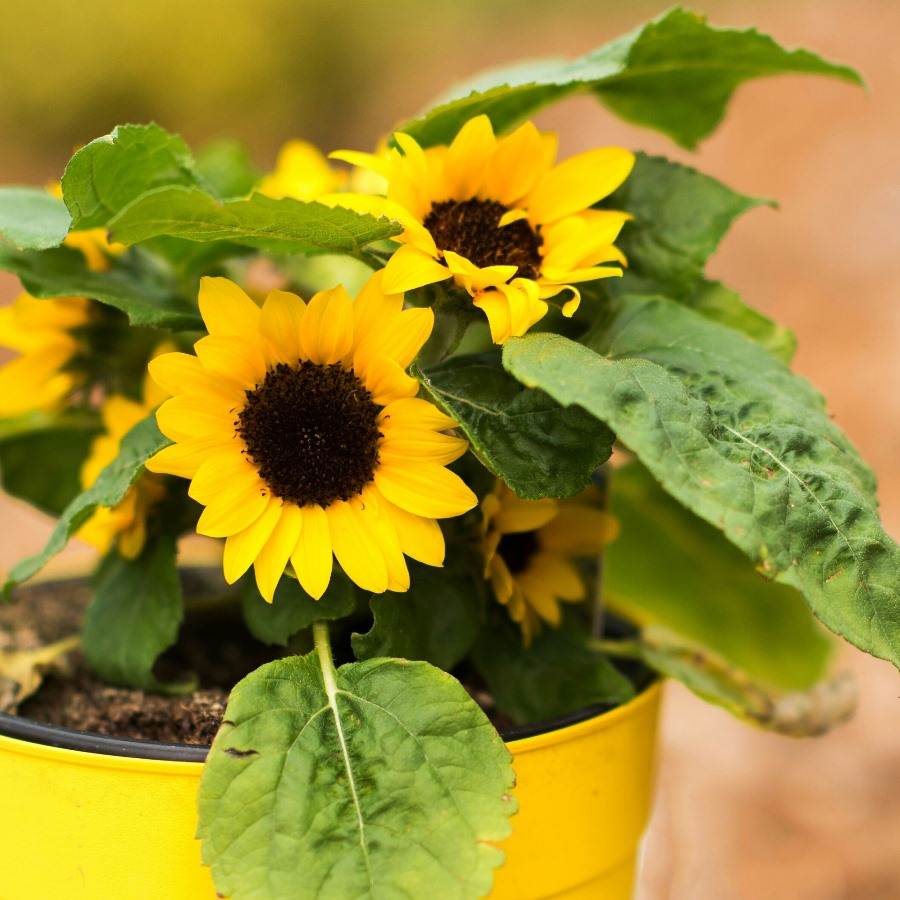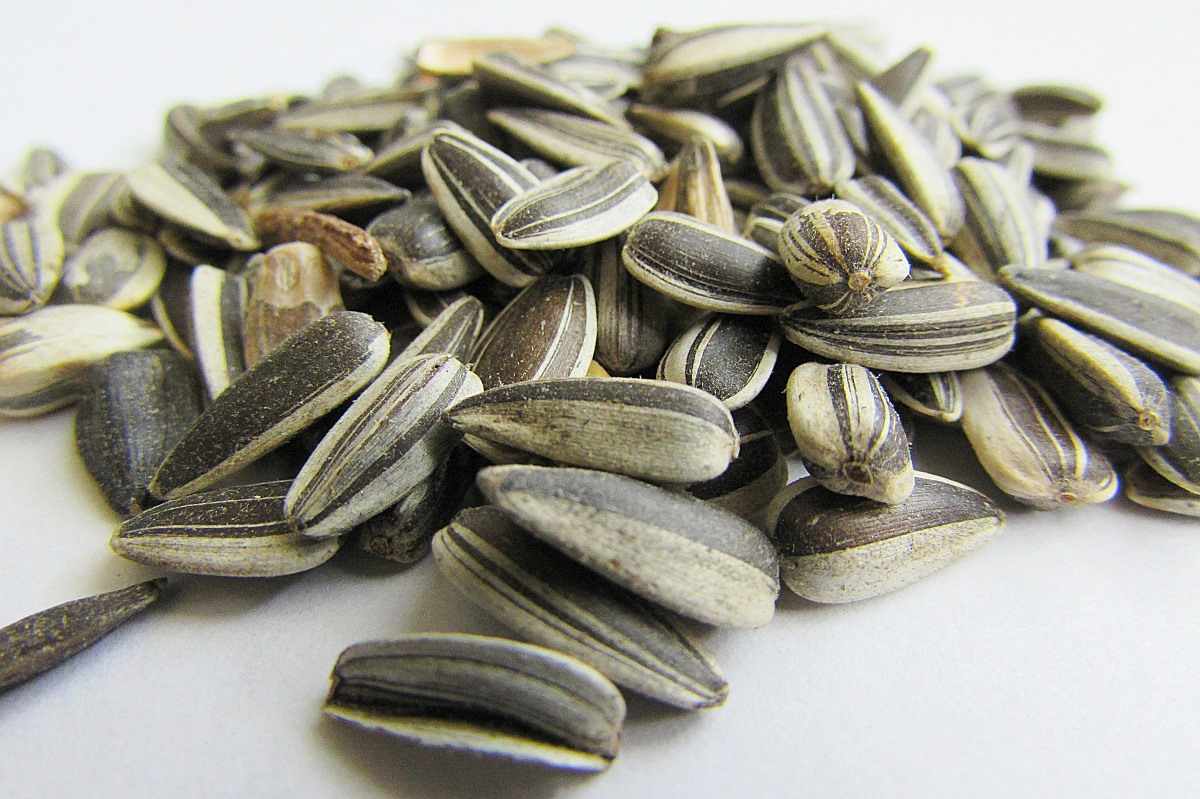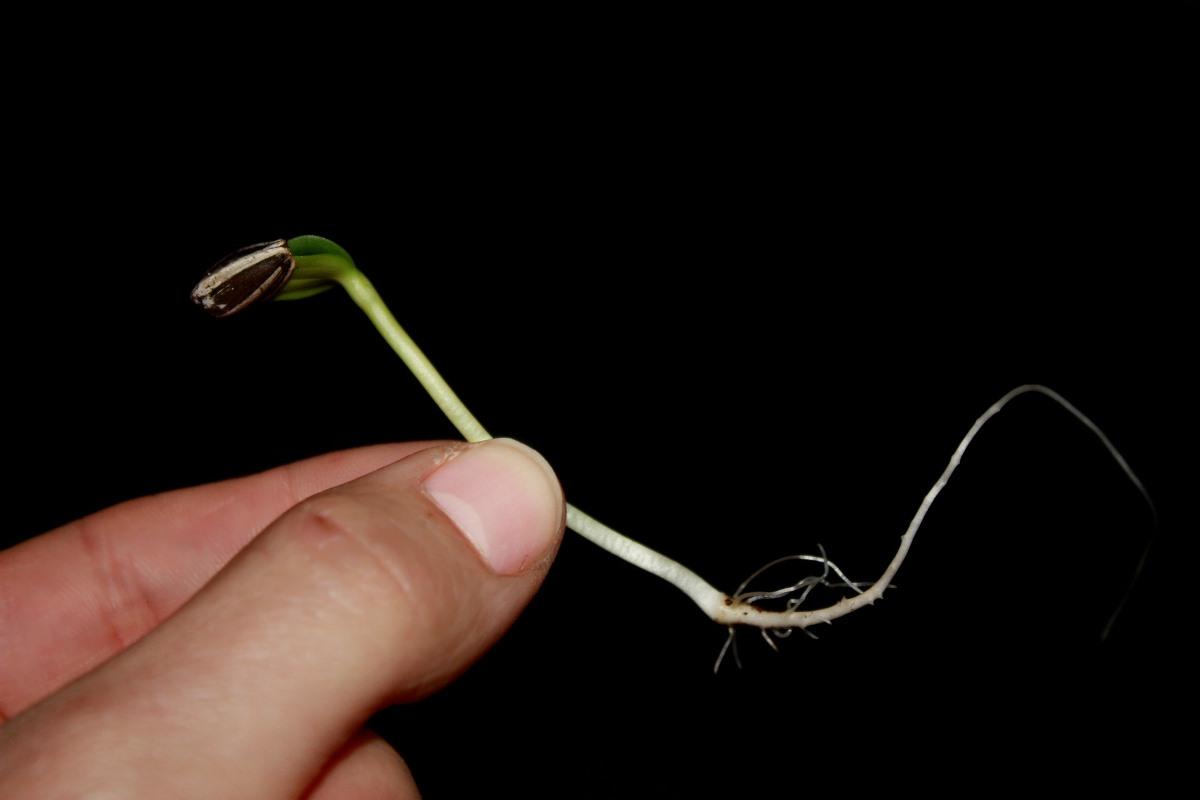Growing Sunflower in Pots
Hello gardeners, do you want to know how to grow sunflowers at home? Well in this article we are going to discuss growing sunflower in pots. You can place these sunflower pots on a balcony, terrace, backyard, even in the Polyhouse or Greenhouse. in this article; we also discuss the related topics.
Introduction to Growing Sunflower in Pots from Seed at Home
Sunflowers are very bright and beautiful flowers. The seeds are very rich in vitamins, proteins, minerals, and phosphorus. Whereas raw sunflower seeds are rich in vitamins B and E and sprouted seeds are rich in vitamin C. Sunflower can be grown at home very easily by selecting the right seeds and going by the mentioned instructions. Sunflower seeds can be consumed raw or mixed with raisins, or even as chips. These seeds can be added to fruits or vegetable salads. Sunflower seeds are also a very good substitute for nuts while baking.
A Step By Step Guide for Growing Sunflower in Pots

Sunflowers are also known by their Latin name that is Helianthus. It is an annual plant with a large daisy-like flower face on top. Sunflower can also make a very bright and happy addition to any sunny place or balcony. Growing a sunflower in a pot is a very easy thing to do that everyone can enjoy. Sunflowers are a low maintenance flowering plant to grow. The flowers are very great for bees and other pollinating insects also, and most of the birds love to eat the seeds.
Things You Will Need for Growing Sunflower in Pots
- Seeds
- Topsoil
- Large container with drainage holes at the bottom
- Saucers or trays
- Watering can or spray bottle
- Low-nitrogen fertilizer
- Stakes
Suitable Soil for Growing Sunflower in Pots
Select a good quality, nutrient-rich topsoil for planting sunflowers in pots. Adding compost to soil makes it very rich in nutrients for your sunflowers. Usage of high-quality topsoil will help you from adding any other drainage material, such as sand or rocks to the bottom of the container or pot.
The high-quality topsoil will have a pH between 5.5 and 7.5, and they even have more than 3 percent organic content in it. These figures will be mentioned on the soil bag you buy.
Suitable Container or Pots for Growing Sunflower in Pots
Choose the right size container for your sunflower plant. You need to choose the size of your container or pot based on the height of the flower you want to plant and as well as how many flowers you want to plant in each container. Generally, most dwarf sunflowers can be planted in a 12 to 16 in or 30 to 41 cm pot or container.
Mammoth variety needs a container that holds at least 5 gallons or 19 L capacity.
If you are not sure about the size you need, better opt for a large size pot or container. Because the sunflower plant needs a lot of room to grow and to survive well.
If you’re reusing a container that was previously used for some other plant, then make sure that it is clean and sterile. You may also have to make drainage holes in a reused container or pot. Without drainage holes, your sunflower seeds may rot.
You can also include a plate or saucer under the container or pot to hold or catch run-off water.
Suitable Location for Growing Sunflower in Pots
Sunflowers are sun-loving plants. So, keep your sunflower in a place that it can receive direct sunlight. As the seedlings grow up, they need as much direct sunlight as possible so that the stems will be thick and strong and they can able to support the large flower head. Once grown, your sunflower plant should have at least 6 to 8 hours of direct sunlight per day.
The heliotropic heads of sunflowers plant will follow the path of the sun. If they are not in direct sunlight, they will bend towards the sun, which may lead to damage to the stem over time.
Propagation for Growing Sunflower in Pots
In case if you miss this: Growing Organic Lettuce.

Sunflowers can be easily propagated from seeds. You can buy sunflower seeds from your local nursery or garden center near to you or you can even order them in online stores.
Sunflower seeds are also available in grocery and other convenience stores, but these are for eating, not for growing. After being roasted, a sunflower seed won’t sprout. Be aware of it before buying. Better consider choosing a dwarf variety of sunflowers to grow in your container or pot, if possible.
Germination of Seeds for Growing Sunflower in Pots
- Broccoli Seed Germination and Selection
- Asparagus Seed Germination and Variety Selection
- Seasonal Flower Gardening: Best Practices for Spring, Summer, Fall, and Winter
- How to Grow Hibiscus from Flower
- Plantation Ideas for Home Decoration: A Beginners Guide
- Flower Garden Designs and Layouts for Beginners
- Planting and Spacing Techniques in Papaya: A Beginner’s Guide
- Growing Gold: Essential Techniques for Planting Pineapples
- How to Make Kalanchoe Plant Bushy: Home Remedies and Solutions

Soil temperature and moisture influence and are responsible for how long it takes for sunflower seeds to germinate, but in most cases, you need to see the sprouts out within 7 to 10 days. When the seedlings have the second set of leaves, then thin them 2 to 3 feet apart if your goal is seed production.
Germination of Sunflower Seeds in A Paper Towel
Step 1) firstly, fold a paper towel in two halves. Fold it in half again to make a square shape and then fill a plastic spray bottle with water and mist the paper towel to dampen it. You should not make it too soggy.
Step 2) Place the folded paper towel in a clean and clear plastic sealable food storage bag. By flattening the paper towel. You need to space 3 or 4 Sunflower seeds evenly apart across the center of the paper towel. After that water, the seeds with a help of an eyedropper and add two drops of water to the towel about 1/4 inches away from each seed.
Step 3) Zip the plastic bag closed, by leaving about a 1-inch opening in the middle or from any side. This open will give the Sunflower seeds the oxygen they need to germinate. Then, you need to press out as much excess air out of the bag as you can. Hold it up to a window with the Sunflower seeds facing the glass of the window. The moist paper towel will adhere to the inside of the plastic bag, and by holding the seeds in one place. This will prevent or help them from falling to the bottom of the bag and tape or stick the sides of the bag to the window. Place a small piece of tape to stick on each side of the bag near the top of it. Then, your Sunflower seeds will germinate in few days.
Step 4) you can check on the progress that sunflower seeds are making day by day. Carefully get the bag down from the window and then lay it flat on the table. You need to feel the paper towel to make sure it is still moist and if it feels dry spray some amount of water into the opening at the top of the bag. Then again re-tape the bag to the window.
Step 5) Plant your sunflower seedling in its small pot or container of potting soil about a week after they germinate. Cover the roots with soil, leaving as much of the stem as possible above the soil level in the pot. Set or place the pots on a windowsill in a warm room or place and keep the soil evenly moist but not very wet or soggy. You should not let it dry out.
Step 6) then, you need to transplant the sunflower to a sunny spot on your balcony, backyard or terrace. Keep the soil evenly moist until you see new growth in a pot, which means that the Sunflower plant has become very well established. Water the sunflower plant once a week or when the soil in a pot or container feels dry to the touch thereafter.
Planting and Spacing for Growing Sunflower in Pots
Plant each sunflower seed about 1 inch or 2.5 cm into the soil in a pot or container. If you wish or want to plant more than one seed in your pot or container, then sow the seeds 4 to 5 inches or 10 to 13 cm apart. Then you need to add a thin layer of compost to the top of the soil after your seeds are sown in a pot or container.
Make sure that you have a radius of 4 to 5 inches or 10 to 13 cm around all sides of each sunflower seed. You should not sow them too close to the edges of the container or pot.
Growing Sunflower in Pots Indoors
Better to choose a small variety for indoor growing. You need to grow your sunflowers in large, individual containers with drainage holes and a well-drained potting mix. This helps in the plant’s fast growth and prevents sitting water.
Place the sunflowers in an area or place where they can receive at least six hours of full sunlight per day – an east or south-facing window is ideal for indoors. If needed, you can expose them to fluorescent full-spectrum lights. The sunflowers won’t grow well if they don’t receive enough light or sunlight.
Put a saucer or tray underneath each pot or container and wet the soil with a watering can until the water drains from the drainage holes. Avoid getting the foliage wet in a pot and always remove the drained water. Water the sunflowers when the top inch of soil feels dry. Aim to keep the soil moist — not soggy every time. For optimum growth, especially focus on regular watering nearly for 20 days before and after flowering.
Fertilize the sunflowers with a water-soluble house plant fertilizer during the starting growing season. Avoid over-fertilizing your plant, because this may stimulate foliage growth instead of new flower growth.
Stake or support the sunflowers if they grow taller than 3 feet and become top-heavy.
Growing Dwarf Sunflowers in Pots
Here is key growing information of dwarf sunflower in pots.
Dwarf sunflower takes 7-14 days at 21-24°C to germinate.
For planning direct seed is recommended — Sow after the last frost in groups of 3-4 seeds, ½ inch deep in container or pot. Then thin it to one plant when true leaves appear.
Transplant — For transplanting sow in the final container, place 1 seed per 6 inches pot or 3 seeds per gallon container, 3-4 weeks before planting out.
You need to grow at 21-27°C during the day and 10-16°C at night. Warmer temperatures cause stretching and cooler temperatures may cause plants to be more dwarf.
Place it in direct sunlight.
Light, well-drained soil of low to moderate fertility is usually preferred for dwarf sunflower.
Water Requirement for Growing Sunflower in Pots
Water your sunflower many times a week. You need to water your sunflowers more often than you do other plants. Check the soil every day or two – it should be constantly very moist. Generally, give your sunflowers about 2 gallons that mean 7.6 L of water a week.
If your sunflower plant is outside, they should be fine with rainwater after they reach 1 to 2 feet that mean 0.30 to 0.61 m in height. If you have a very hot, dry day you may need to compensate.
As the flower grows, needs to water the root zone in a 3 to 4 in or 7.6 to 10.2 cm radius around the plant itself.
Always keep a spray bottle handy and spritz the flower head with water regularly.
When Do Sunflowers Bloom?
Sunflowers start blooming in summer and early autumn. The peak most flowering time is around midsummer. These blooming timings are dependent upon when you plant your sunflower seeds and the weather conditions where you live or stay.
Providing Support to the Sunflower Plant
Stake your sunflower plant if necessary. Some selected dwarf varieties may not grow tall enough to need support. However, if your sunflowers reach a height of 3 feet or nearly 0.91 m or taller, they should be need anchored to something to keep the flower head from drooping.
You should not anchor your support within the pot itself. When your sunflower reaches full height, it may tip out the pot over. You can tie the stake to a drainpipe, wall, or another object.
Suitable Fertilizers for Growing Sunflower in Pots
Add fertilizer if required. While sunflowers don’t necessarily need additional feeding to grow well, adding fertilizer can even make the colors on your flower heads brighter and bolder. You can start with a high-nitrogen liquid plant fertilizer, and then switch to one with more phosphorus when the bud begins to bloom out.
You can also add liquid or diluted fertilizer to your sunflower’s water. Take care not to over-fertilize your sunflower because the stem may break down.
Pests and Diseases of Sunflower Growing in Pots
The sunflower diseases are listed below:
- Alternaria leaf blight
- Downy mildew
- Phoma blight
- Powdery mildew
- Septoria leaf spot
- Verticillium wilt
The sunflowers pests are listed below:
Most bugs affect the sunflower plant. They are
- Aphids
- Mealybugs
- Scales
- Mites
When to Harvest Sunflower Seeds
Harvesting sunflowers is very easy, but deciding when to harvest sunflowers can give some gardeners to be paused. Heads picked before the right time may have many seed coats with little meat. Wait too long to harvest or reap sunflowers and therefore the tender seeds will be too dry to roast. Wait until the animals start sunflower harvesting for you and there’ll be nothing left for you to harvest. You need to harvest sunflowers when their petals become dry and begin to fall. The green base of the head of the flower will turn yellow and eventually brown. Seeds will look up plump and the seed coats will be fully black or black and white stripes depending on the variety you choose or select.
Commonly Asked Questions for Growing Sunflowers in Pots
Why my potted sunflower is dying?
You need to water the sunflower more often than you have been if you allowed its soil to dry too much, the plant will no longer grow well and its lower leaves yellow and drop. Water the sunflower’s soil thoroughly, by stopping when water seeps from the pot’s drainage holes.
What is the average lifespan of a sunflower?
The average lifespan of a sunflower is 1 to 2 weeks.
Should I repot my sunflower plant?
Single-stem sunflowers can only grow one flower from one seed. If you want to keep sunflowers all the summer, you’ll have to replant them every 10 to 14 days.
Do sunflowers bloom more than once?
Sunflowers do not grow and bloom again.
Can you grow sunflowers in grow bags?
You can grow sunflowers in any type of container or pots including grow bags, raised beds, and of course, ordinary gardening pots. And you can even leave the potted sunflowers either indoors or outdoors. Growing in grow bags is the same as growing in other pots or containers.
Why my sunflower seeds are not germinating?
If there is no proper care taken the seeds may not germinate. Even if you took dry seeds they may not sprout easily.